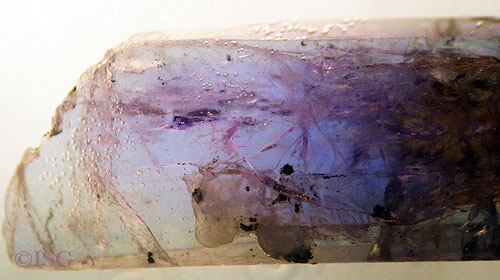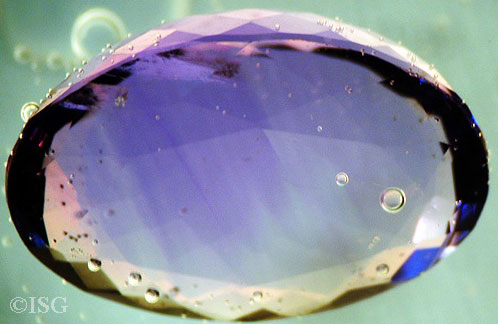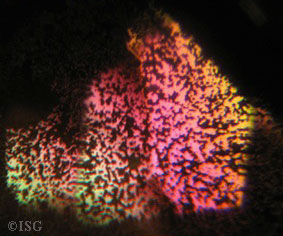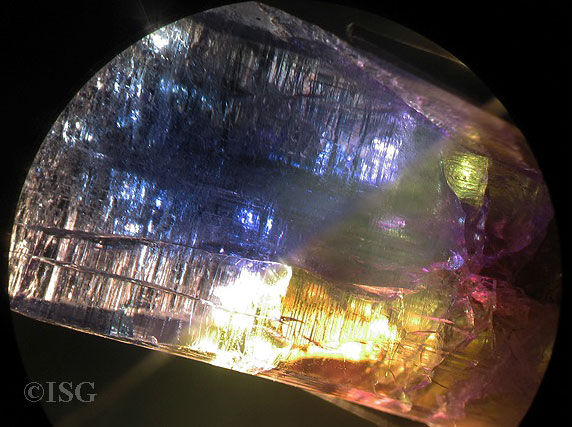

Insanity is doing the same thing over and over again and expecting different results.
Albert Einstein
Tanzanite trepidation
Robert James of the International School of Gemology is certainly no Einstein and has proven it once more in his 1 November 2012 missive entitled "Tanzanite Trepidation".
Straight out of the gate, gemmology's super sleuth claims to have prima facie evidence of yet another nefarious gem treatment, hitherto undetected by the world gemmological community.
What, pray tell, could it be?
Tanzanite.
And who are the bastards responsible for this fraud?
The Thais and Chinese.
Like we said, he's no Einstein.
Evidence
Obviously this is a serious charge. Tanzanite is one of the most popular coloured gemstones on the planet. Thus he must have some majorly humongous evidence to be rubbishing this staple of the gem business, right? Let's review that "evidence".
According to Robert James, the stone is treated because...
- There has been a surge of inexpensive tanzanite into the market.
As evidence for this claim, Robert James of the International School of Gemology provides... nothing, nada, niente. Mai mee arai. Not a damn thing. - The International School of Gemology's Robert James saw purple colour in the cracks of a tanzanite he purchased when the stone was immersed in his dunce-cup immersion cell.

Here the Mickey Mousketeer of the International School of Gemology demonstrates prima facie evidence of his ignorance. You see, tanzanite is strongly pleochroic. When light strikes a highly reflective surface that is somewhat flat (like the surface of a pond or the bonnet of a car), it will be partially plane polarized parallel to that surface. This is the operating principle of polaroid sunglasses. If the transmission direction of the sunglass's lenses is at right angles to that direction, the glare gets filtered out, improving vision.
In a gemstone, a reflective fissure acts the same way, causing partial polarization of the light parallel to the fissure surface. Nothing happens in a singly refractive gem, but in a pleochroic gem like tanzanite, the fissure surface often takes on a pleochroic colour different from the body colour seen in the microscope. Not to mention the mirror-like surface of the fissure acts like... a mirror. Voilà, you have what Robert James labels prima facie evidence of "infusion" (formerly dyefusion). Except that it is an entirely natural phenomena called pleochroism and reflection. This man is no Einstein. - The International School of Gemology's Robert James found (shudder) growth zoning in a tanzanite he purchased.
Call the police! And please ignore the gas bubbles that are the result of his use of water instead of a proper immersion fluid. None of the bubbles below are inclusions in the gem, but simply represent yet another example of "tester incompetence".

- The International School of Gemology's Robert James discovered a large tube open to the surface filled with a reddish substance in a tanzanite he purchased, and cited it as evidence of "infusion".
While he has lavishly praised the Koivula/Gübelin Photoatlas of Inclusions in Gemstones books, he obviously hasn't cracked them open too often, for Volume 2 details precisely such corrosion tubes on pages 804–805. - The International School of Gemology's Robert James discovered a tanzanite crystal with "annealed graphite", implying that these are crucible relics from the heating process.
Dear, dear, dear, our poor chap is unaware that the tanzanite mines of Merelani are one of the richest concentrations of graphite on the planet.
- The International School of Gemology's Robert James found a fissure showing interference colours in a tanzanite he purchased.
Again, reaching for the Photoatlas Volume 2, we find the same phenomena illustrated with several examples on pages 806–807.
Robert James, Time Traveller
We've saved the best for last. Breaking out the trusty Chelsea Filter, he proceeds to commit unspeakable actions with that tool. B.W. Anderson is raging somewhere.
But worse was yet to come, and we doth quote:
The final test that exposed the condition of this tanzanite crystal was quite unexpected and profound. This crystal, viewed through a London Dichroscope below, clearly demonstrated that something very strange has taken place with this crystal. This image clearly exhibits four separate colors coming from this tanzanite crystal, with the blue and purple coming from the fractures and fissures, and the crystal itself offering a colorless and strong yellow reaction. One direction of viewing through a London Dichroscope, but producing four distinct colors. We believe that 2 of the colors are optical reactions from the gemstone, and 2 are due to optical reactions of the treatment material.
We apologize, but to respond to this we must engage in a bit of science. Physical space is normally delineated in three dimensions labelled X, Y and Z. X and Y lie in the same plane, which is up-and-down and side to side. Z represents depth, or the in-and-out.
The dichroscope was created to examine the phenomena of pleochroism, which is a function of crystal lattice distortion in non-isometric crystals. Isometric (cubic) crystals are the same in all three dimensions and so light will be absorbed the same no matter what direction it travels through the crystal, provided the colourant is evenly distributed. This is also true of amorphous gems such as glass and opal.
In uniaxial crystals, the lattice is compressed or stretched in one dimension (the up-or-down or side-to-side). This means two dimensions are the same and one is different. This can result in light being absorbed differently in one dimension compared with the other two, creating dichroism.
Biaxial crystals such as tanzanite are distorted in all three dimensions. This can create trichroism. Indeed, tanzanite is strongly trichroic. Tanzanites don't just do the up-to-down or side-to-side, but also do the in-and-out.
But Robert James found—we recommend sitting down for this—four different colours in his tanzanite.
There you have it. The Mr. Bean of the International School of Gemology discovered the fourth dimension in a tanzanite. He has not only found the up-and-down, side-to-side and in-and-out, but the imaginary space between the B and S dimension. Bravo! Who wouldda thunk it?
Alas, 'twas not to be. We do pine for the day that he will slip into an alternative universe (and stay there), but are not yet so lucky. His tanzanite was simply colour zoned, as the photo he published below clearly shows. God only knows how many colours he'll discover if he waves his dichroscope over some tourmaline. Did we mention that he is no Einstein?
Scolded again
Robert James concludes with this admonition:
To the cookers responsible: You folks are brilliant! We need more tanzanite on the market, both natural and treated. But we need your treated material to be properly disclosed because failure to do so is destroying the entire tanzanite market for everyone. Disclose your treatments! Otherwise you will eventually cause great damage to the market for tanzanite just as you did for Ruby, Paraiba Tourmaline and Oregon Sunstone.
The ISG will not stand down in our efforts to expose the selling of undisclosed treated gemstones.
This man is no Einstein. We have no trepidation whatsoever in saying that.
••••••••••••••••
World Gem Society Members
Following this newsletter, Robert James lists a number of "approved" gem dealers for the intrepid gem buyers to purchase tanzanite from. Interestingly enough, they all appear to be World Gem Society members. This is disturbingly similar to the scheme he previously employed while working in the Caribbean, where he gives blessing to those who pay his membership dues and trashes the product of those that don't (that little stunt got him sued by Diamonds International).
One can only wonder why anyone of the companies listed at the bottom of Robert James' International School of Gemology/World Gem Society newsletters would want to be associated in any way with someone trashing the very product they sell—particularly when his reports are based on rubbish science. Once again, it simply leaves us gobsmacked.
••••••••••••••••
About us

We are the Gobsmacked Gang, those who cannot believe the things that spring from the mouth of the International School of Gemology's Robert James, the Mr. Bean of the gemmological world. Please note that the Gobsmacked Gang has nothing to do with what appears to be yet another Robert James attack site FakeGemology.com, which is designed to hurt someone making an honest attempt at teaching gemmology. Once again, as is copiously detailed on our Files page, James reveals what an evil little spawn he is. We would pray for his soul, but there is no evidence he has one. Thus we suggest a career change. A man like this certainly belongs in the Trump administration.
Testimonials
"If I were to catch any of my ISG Registered Gemologists or Registered Gemologist Appraisers trying to pull the stunts that you are pulling on eBay, I would pull their diplomas, publicly expel them from the ISG, and personally make sure that they did not work again in this industry with anything but a broom in their hand."
— Robert James
"They [the insurance industry] do not take kindly to frauds being perpetrated on consumers."
— Robert James
Read about the Robert James eBay fraud in our article here.